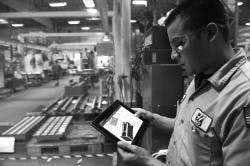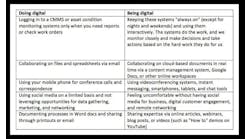Training (and enticing) a digital workforce using digital tools
Dozuki recently announced a collaboration with 3M Ventures in order to deliver its work-instruction training software to manufacturers of all sizes to help them achieve digital-transformation goals.
“The ability to leverage the organizational and manufacturing expertise of an industry
Dozuki's Eric Doster
leader like 3M is a major milestone for our team,” said Eric Doster, CEO and co-founder of Dozuki. “This collaboration allows us to ramp up our product development and market outreach efforts.”
We’re always intrigued by training and education in the digital/industrial space, so we connected with Eric to learn more. Take a look…
Smart Industry: Describe this work-instruction training software.
Eric: Dozuki is standard work instruction software that empowers manufacturers to implement standardized procedures in support of continuous improvement and training efforts. With built-in document control, approval processes, training modules, multimedia support, language translation, analytics, and more, our platform helps companies bridge the gap between continuous-improvement initiatives and employee knowledge.
Smart Industry: How does it enable digital transformation?
Eric: A key part of many digital-transformation strategies is the documentation and standardization of procedures. At its core, digital transformation is about connecting people, processes, and technology in order to provide valuable insights and improvement opportunities for businesses. In connecting these three operating areas, we are enabling businesses of all sizes to standardize procedures, train to standards, analyze results, and improve future standards.
Electronic work instruction on the factory floor
Smart Industry: Who are the intended users? What are overarching goals?
Eric: Our platform is built for manufacturers of all sizes, across all industries. Common goals we hear from our hundreds of customers are: needing to standardize their training programs, visibility into procedures in order to implement efficiency gains/reduce waste, distribute procedure updates quickly to the shop floor, and so much more.
Smart Industry: What personnel challenges are most common with digital transformations in the industrial space?
Eric: In our experience working with manufacturers across all sizes and industries, digital-transformation strategies run into roadblocks when they are implemented from the top down with little regard for those that carry out the work. When the greater workforce hasn’t been engaged in the process, it becomes much easier for them to resist the change. Our solution aims to connect the workforce (the people) with the digital-transformation strategies in order to achieve sustainable success.
Smart Industry: Why is it hard to get people to buy in? What's the fix?
Eric: Once manufacturers attempt to develop a strategy for connecting employees to their technology and processes, it can become quite challenging to implement. We can’t blame them. It’s a new era with more technology to choose from; knowing where to start isn’t clear. Providing an easy-to-use platform where employees can share their knowledge with others across shifts, locations, and job functions helps companies create a valuable knowledge base.
Smart Industry: How does the younger workforce come into play here?
Eric: Younger employees are considered ‘digital natives.’ They are more comfortable with new technologies than their predecessors. But many have an outdated perception of manufacturing. In reality, most modern manufacturing jobs are for skilled production workers in roles such as technicians, data analysts, operators or machinists. It’s up to manufacturers to actively change these outdated perceptions of the industry in order to attract more qualified candidates.
A younger workforce is used to digesting instructions via YouTube videos and visual means, providing us a unique opportunity to bring our ‘media first’ approach to procedures and training to an eager audience. As manufacturers deal with a widening skills gap they are looking for unique ways to recruit new employees to fill open positions. In order to better recruit and engage these younger workers, manufacturers need to demonstrate that they are implementing these technologies.
Smart Industry: What most excites you about this initiative?
Eric: By bringing our solution into more manufacturing environments, we are able to help support and grow this integral part of our domestic economy.





